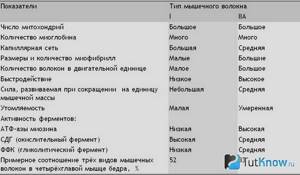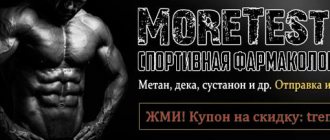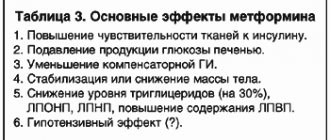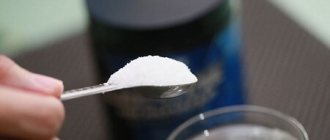As you know, there are several types of fibers. To develop each type, it is necessary to use your own training methodology. From a practical standpoint, athletes now have the opportunity to build more mass while also avoiding overtraining. This alternation is called microperiodization in bodybuilding according to the type of muscle fiber. Thanks to the cyclical nature of training and the availability of appropriate development methods for each type of fiber, it has become possible to achieve supercompensation. Let's take a closer look at all types of fibers.
Types of muscle tissue fibers
It is customary to divide fibers according to the myofibril ATPase enzyme and the number of mitochondria.
It should be noted that the fiber ratio is genetically determined and cannot be changed. However, knowledge about the type of fiber will significantly increase the effectiveness of the training. All fibers respond differently to training methods and also have different susceptibility to hypertrophy. Thus, the athlete needs to select the most effective training methods in accordance with the presence of certain types of fibers in the tissues of his muscles.
Types of fibers according to the enzyme ATPase myofibril

Slow ones are able to perform work over a long period of time and more economical mechanisms, namely oxygen, are used to provide energy. Since oxygen enters the tissues along with the blood, slow fibers are also called red fibers. The aerobic energy supply system for fibers is turned on at the moment when the reserves of creatine phosphate and glycogen are exhausted. After this, energy begins to be produced using aerobic mechanisms using oxygen. Slow fibers have no less growth potential than fast fibers. Since the main goal of bodybuilding is to gain muscle mass, it is necessary to develop both types of fibers. This is where microperiodization in bodybuilding based on the type of muscle fiber will help, which we will talk about below.
The most effective method of training slow fibers is pumping. Without going deeply into the mechanisms of fiber growth, slow fibers also require hydrogen ions and muscle failure. Thus, we can deduce the optimal method for training slow fibers. It consists of performing 4 sets of 20-30 repetitions each. You need to rest for one minute between sets, and 5 minutes between performing different exercises.
Fast fibers, in turn, are also divided into two types - 2A and 2B. 2A fibers are somewhere between fast-twitch and slow-twitch fibers, as they can receive energy from both anaerobic and aerobic sources. In turn, type 2B fibers are provided with energy only from anaerobic sources.
To train type 2A fibers, you should use sets of about five repetitions or the same techniques that are aimed at developing strength or mass. Thanks to the ability to use energy from different sources, they can train in different ways. But for type 2B training, only strength training methods are suitable.
Types of fibers by number of mitochondria

However, it is necessary to say a few words about the second type of fiber classification. Based on the number of mitochondria, fibers are usually divided into glycolytic and oxidative. Glycolytics have a small number of mitochondria and acidify very quickly. For this reason, they cannot work for a long time. Their energy is obtained from anaerobic sources. For training this type of fiber, strength techniques are best suited with the number of repetitions per set from 3 to 5. You should rest for five minutes between sets.
Oxidative fibers contain many mitochondria, and these are the ones most often trained by athletes. Oxidative fibers are designed for sustained work and are best developed through muscle failure.
Microperiodization of load.
Microperiodization of loads is an important element of any adequate training program for “natural bodybuilding”. Yes, when using pharmacology you can progress linearly for much longer, although this does not eliminate the need to use meso and macro cycles. The bottom line is that the body’s adaptive reserve during “chemistry” is much higher, so all muscular and non-muscular systems are restored much faster, as a result of which the athlete can afford 3 or 4 hard workouts per week.
It is clear that without the support of pharmacology, a person using adequate training schemes will not be able to train like this for a long time, since this will simply lead to overtraining.
That is why at a certain stage, which occurs approximately when the athlete's strength indicators are 150, 200 and 220 percent of his own weight in one repetition in the bench press, squat and deadlift, respectively, the athlete is forced to make a choice between sports pharmacology and microperiodization. By the way, even if you prefer the first, you still won’t be able to avoid the second in the future, you’ll just postpone the need to use this technique for some time. The fact is that differences in the speed of recovery of various systems, sooner or later, will make themselves felt, and progress in speed-strength indicators will require you to use increasingly sophisticated methods of deepening training stress, the excessive complexity of which will force them to alternate even case if you use "pharma".
When it comes to strength sports, microperiodization most often concerns indicators such as intensity and volume. Intensity regulates the qualitative indicator of the load, namely the percentage of the personal maximum that the athlete uses. Volume, accordingly, regulates the number of barbell lifts per workout. An example of maximum intensity and minimum volume is singles, where an athlete performs an exercise for 1 repetition with a maximum weight. Accordingly, microperiodization involves manipulation of these two indicators. The simplest training schemes offer manipulation only with the intensity indicator, when the athlete alternates training with 100% of the working weight and 75-50% during the training cycle. In particular, such a scheme is the Plintovich system, which you can find on the Internet.
More complex training regimens allow the use of various motor units and non-muscular systems of the body. In particular, in one workout an athlete may perform exclusively chest presses in the 6-2 rep range, and in the next workout, in one training cycle, perform more basic and conditioning movements in the 6-12 rep range. In addition, an athlete can reach “muscle failure” in one workout, and simply “pump up” the muscle in another. Such schemes are already drawn up more individually, taking into account the various genetic characteristics of the athlete, as well as his goals. You can find similar training programs in the works of Chernorutsky, Verkhoshansky, Roman, Sheiko and other weightlifting and powerlifting methodologists.
- < Back
- Forward >
Microperiodization according to muscle fiber type

Slow fibers require 2 to 3 days to fully recover, after which they can be developed again. Type 2A fast fibers recover within one or two days. Now we are talking about the fact that in each lesson you use training of certain muscle groups, since large ones require about two weeks to recover. Thus, for example, training type 2A fibers of the leg muscles should be carried out once every 14 days.
But 2B fibers can be trained every day, but it should be remembered that when working on this type of fiber, the central nervous system is very heavily loaded and requires at least a day of rest to restore it.
To put it simply, to train each type of fiber, you need to use the following periodization:
- Heavy training - singles are used;
- Medium - type 2A fibers are worked;
- Light - pumping.
Thanks to this alternation, you can effectively work all fibers and give them the necessary time to recover.
In this case, you should remember the need for separate training of muscle groups. All this together will allow you to achieve the desired result and avoid overtraining. Of course, you have to work hard on your training program to take into account all the nuances. But then you will be able to achieve your goal much faster. For more information about microperiodization, see here:
Periodization in sports
Periodization is a cyclical variety in training to prevent the body from adapting to stress.
All professional athletes use it, and amateurs, as usual, focus on the best. Periodization cycles consist of 4 to 6 cycles, which carry a specific goal and direction. When your body is accustomed to training and already weakly reacts to it, you change the direction of the load and give a new challenge to your body so that it can cope with it; the body begins to work hard again, thus increasing strength and mass.
Each cycle lasts 8-12 weeks, after which it is replaced by a completely new one, which causes new stress for the body and leaves no chance for working in a calm mode.

Periodization in bodybuilding and General Adaptation Syndrome
General Adaptation Syndrome, described by Hans Selye, considered the father of stress management, provides the basis for understanding how we respond to training. GAS develops in three stages.
Alarm stage
The first time we encounter stress is when we are not prepared for it. Remember the first time you squatted or did an exercise for the first time? The next day you were in pain. Today, many bodybuilders generally consider a workout a failure if they don't feel sore the next day, and there is some truth to this.

What causes this pain? You are doing an exercise for which your muscles are not ready. At the local level, microtears of small muscles form, swelling occurs, and water rushes to the sites of inflammation, causing pain. But on a general level, unpreparedness for a given stress forces the body to adapt to it. That is, the stress factor has become an alarm for the body - pain has appeared, it’s time to adapt!
Well, what about the next time you put the same stress on your muscles (same weight, same exercise, etc.)? There won't be such pain anymore, will there? And why? But because the next phase has arrived - the stage of resistance.
Resistance stage
At this stage, the body has already received the first alarm signal and is actively trying to repair the damage received. Fine? Yes, but how will it repair the fibers, to what level? Same as before? No.
What good is it to simply restore muscles to the same functional level? Your body is damn smart, it repairs the fibers so that the next time you stress them, there won't be the same alarm! That is, he gains muscle so that repeated stress is easier to cope with. The body does everything possible to prevent the next alarm.
This is how we grow! The body constantly adapts after another alarm, adding muscle to itself, making it bigger. It constantly responds to new stresses, constantly repairing fibers. This reaction is inherently defensive, and we need to understand this in order to effectively plan training and understand periodization in bodybuilding.
No wonder bodybuilders strive for pain! It makes sense. No pain means no alarm. No alarm means no reason to adapt. And if there is nothing to adapt to, then there will be no growth. Do you understand?
Exhaustion stage
Now, if the alarm signals are too intense or too frequent, then you are not allowing your body to fully complete the resistance stage. That is, you do not become stronger, but only exhaust yourself. In fact, this is where overtraining begins. At this stage, you do not adequately define and distribute your training. There is an art to determining how many alarms there should be and when they should sound!

The body constantly adapts after another alarm, adding muscle to itself, making it bigger. It constantly responds to new stresses, constantly repairing fibers. This reaction is inherently defensive, and we need to understand this in order to effectively plan training and understand periodization in bodybuilding.
Important question
Without a doubt, many bodybuilders do not understand the essence of general adaptation syndrome. They do the same thing over and over again, instead of asking themselves the single most important question: “Is there anything I can do differently today?”
Do you get the idea? Variations are the key! General adaptation syndrome determines how you respond to training. Your muscles grow not just from training, but from varied training! They won't necessarily grow from hard training, they will grow from varied training! They won't necessarily grow from more frequent training, but they will grow from varying training!
“What can I do differently today?” That's what your body wants to know! It's like asking, "What do I need to do to give my muscles something to adapt to by enlarging muscle fibers?" or “How much stress must I apply before the alarm bells sound and my body is forced to repair and grow?”
Now do you understand why weightlifters and powerlifters (and all other periodizers), even though their annual training plan is planned out in advance, use variations throughout the year, several months, weeks and even days? Knowing that in a three-month mesocycle their training is aimed at achieving a specific goal, they still allow for daily variations in training! Today's workout is always different from yesterday's, and this chest workout should be different from the last.
Yes, it’s easy to do the same thing monotonously every time, isn’t it? Stop it! Variability, variability and more variability is the key to growth! Anyone familiar with periodization understands this perfectly. Remember to ask, “What can I do differently today?” If you forget about him, you'll be repeating the story of that guy from Florida who never grew up!










